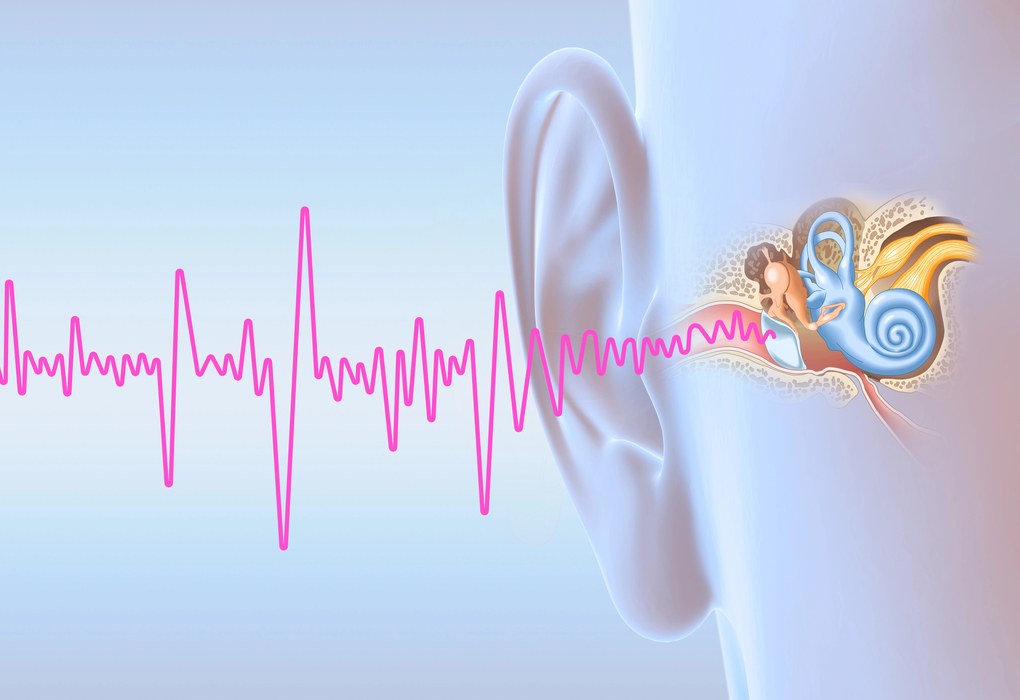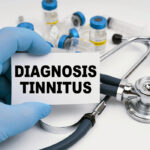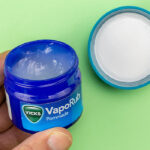Key Takeaways
- The Lenire device combines sound therapy with tongue stimulation (bimodal neuromodulation) to provide relief for tinnitus sufferers, with 79.4% of clinical trial participants experiencing significant improvement after 12 weeks.
- Real-world clinical data shows even higher success rates, with 91.5% of patients reporting clinically meaningful tinnitus reduction and 89.2% finding the treatment beneficial to their tinnitus journey.
- FDA approval in March 2023 marked Lenire as the first non-invasive bimodal neuromodulation device specifically authorized for tinnitus treatment in the United States.
- The device is designed for self-administration at home, requiring just 30-60 minutes of daily use for optimal results.
- While not a cure, Lenire represents a significant advancement over traditional sound-only therapies, especially for those with moderate to severe tinnitus symptoms.
Tinnitus Relief Breakthrough: How the Lenire Device Works
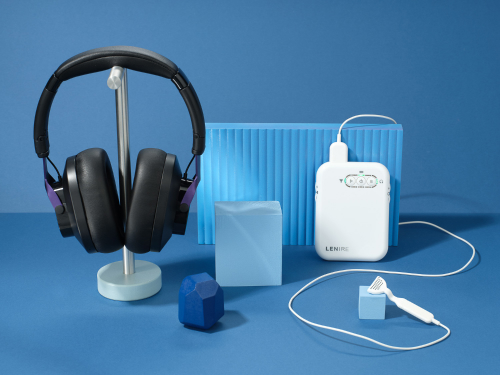
“Lenire Tinnitus Treatment in Austin TX …” from rkaudiology.com and used with no modifications.
Tinnitus affects millions worldwide, yet effective treatments have been frustratingly limited. The Lenire device represents a genuine breakthrough in tinnitus management, combining two distinct sensory stimulations to address the neurological basis of tinnitus. Unlike traditional sound maskers or hearing aids that only provide temporary relief, Lenire works to actually retrain the brain’s response to tinnitus through consistent, calibrated stimulation.
Developed by Neuromod Devices in Ireland, Lenire is a portable, non-invasive medical device that patients can use at home. The system consists of wireless headphones that deliver carefully selected tones and a small intra-oral device called the Tonguetip® that sits on the tongue and provides gentle electrical stimulation. This dual-sensory approach is what makes Lenire unique in the tinnitus treatment landscape. Patients typically use the device for 30-60 minutes daily over a 12-week treatment period, making it a manageable addition to daily routines.
What sets Lenire apart is its bimodal neuromodulation approach. Rather than simply masking the sound of tinnitus, the device aims to address the underlying neural hyperactivity believed to cause tinnitus. By simultaneously stimulating the auditory system through sound and the somatosensory system through the tongue, Lenire promotes neuroplasticity – the brain’s ability to reorganize itself by forming new neural connections. This approach aligns with current scientific understanding that tinnitus involves multiple brain regions, not just the auditory system.
Clinical Evidence Behind Lenire’s FDA Approval

“Lenire: A New Era in Tinnitus Treatment …” from www.youtube.com and used with no modifications.
The journey to FDA approval for Lenire was built on substantial clinical evidence demonstrating both its safety and efficacy. The device received De Novo approval from the FDA in March 2023, marking a significant milestone as the first non-invasive bimodal neuromodulation device specifically authorized for tinnitus treatment in the United States. This approval wasn’t granted lightly – it came after rigorous evaluation of clinical trial data showing impressive results across diverse patient populations.
The pivotal research supporting FDA approval came from multiple large-scale clinical trials conducted across Ireland, Germany, and the United States. These studies collectively enrolled hundreds of participants with varying degrees of tinnitus severity, providing a comprehensive picture of the device’s performance. Importantly, these trials utilized standardized, validated measures of tinnitus impact, including the Tinnitus Handicap Inventory (THI) and Tinnitus Functional Index (TFI), allowing for objective assessment of treatment outcomes.
TENT-A3 Trial Results
The TENT-A3 clinical trial represents one of the most compelling pieces of evidence supporting Lenire’s effectiveness. This study enrolled 112 participants with tinnitus and employed a unique design to evaluate the impact of bimodal stimulation versus sound therapy alone. Participants first underwent six weeks of sound-only therapy, followed by six weeks of the full Lenire treatment combining sound and tongue stimulation. This sequential approach allowed researchers to directly compare the two interventions within the same patient population.
The results were striking: 79.4% of participants experienced clinically significant improvement after the full 12-week study. Even more telling, 70.5% of patients with moderate or worse tinnitus reported significant improvement following the six weeks of bimodal stimulation with Lenire, even after reporting insufficient improvement with the initial six weeks of sound therapy alone. This demonstrates that the addition of tongue stimulation provides benefits beyond what can be achieved with sound therapy by itself – a finding that validates the bimodal neuromodulation approach at the core of Lenire’s design.
“The TENT-A3 trial showed that 79.4% of participants experienced clinically significant improvement after 12 weeks with Lenire, and 70.5% of those with moderate or worse tinnitus improved significantly after adding tongue stimulation to their treatment regimen.” – From Scientific Translational Medicine publication
Real-World Success Rates from U.S. Patients
While clinical trials provide essential validation, real-world results often tell an even more compelling story. Since receiving FDA approval, Lenire has been implemented in audiology clinics across the United States, generating valuable data on its performance outside the controlled environment of clinical studies. These real-world outcomes have been remarkably positive, in some cases exceeding the results seen in formal trials.
Real-World Success Rates from U.S. Patients
While clinical trials provide essential validation, real-world results often tell an even more compelling story. Since receiving FDA approval, Lenire has been implemented in audiology clinics across the United States, generating valuable data on its performance outside the controlled environment of clinical studies. These real-world outcomes have been remarkably positive, in some cases exceeding the results seen in formal trials.
In one notable study from an audiology clinic in Alaska focusing on patients with moderate to severe tinnitus, an impressive 91.5% of patients reported clinically meaningful reduction in their tinnitus symptoms after using Lenire. Perhaps even more telling, 89.2% of these patients specifically stated that Lenire was beneficial for their overall tinnitus journey. Dr. Jason Brenner, an audiologist who has fitted more than 120 tinnitus patients with the Lenire device, reports a success rate exceeding 85%, calling the device “a game changer” for tinnitus management in his clinical practice.
These real-world results are particularly important because they demonstrate that Lenire’s benefits translate effectively from controlled research settings to everyday clinical use. The consistency between trial data and real-world outcomes provides strong reassurance to both clinicians and patients considering this treatment option. As more U.S. patients receive Lenire treatment, this growing body of real-world evidence continues to strengthen the case for bimodal neuromodulation as an effective tinnitus intervention.
Comparing Lenire to Traditional Tinnitus Treatments
When evaluating Lenire, it’s important to understand how it compares to traditional tinnitus management approaches. Conventional treatments have typically included sound therapy, cognitive behavioral therapy (CBT), hearing aids, and tinnitus retraining therapy (TRT). While these approaches can provide relief for some patients, many continue to struggle with persistent symptoms despite trying multiple interventions.
The TENT-A3 trial directly compared Lenire to sound therapy alone, finding that the addition of tongue stimulation significantly enhanced therapeutic outcomes. This is particularly meaningful because sound therapy has been a cornerstone of tinnitus management for decades. Beyond just comparing efficacy rates, Lenire offers several practical advantages over traditional treatments: it’s non-invasive, requires no surgery or drugs, can be self-administered at home, and delivers measurable results in a relatively short timeframe (12 weeks for the standard protocol).
Unlike hearing aids, which primarily benefit patients whose tinnitus is associated with hearing loss, Lenire can be effective for tinnitus sufferers regardless of whether they have hearing impairment. And unlike purely psychological approaches like CBT, Lenire directly addresses the neurological aspects of tinnitus through physical stimulation of neural pathways. This multi-faceted advantage makes Lenire a valuable addition to the tinnitus treatment landscape, especially for patients who haven’t found adequate relief through conventional methods.
Inside the Technology: Bimodal Neuromodulation Explained
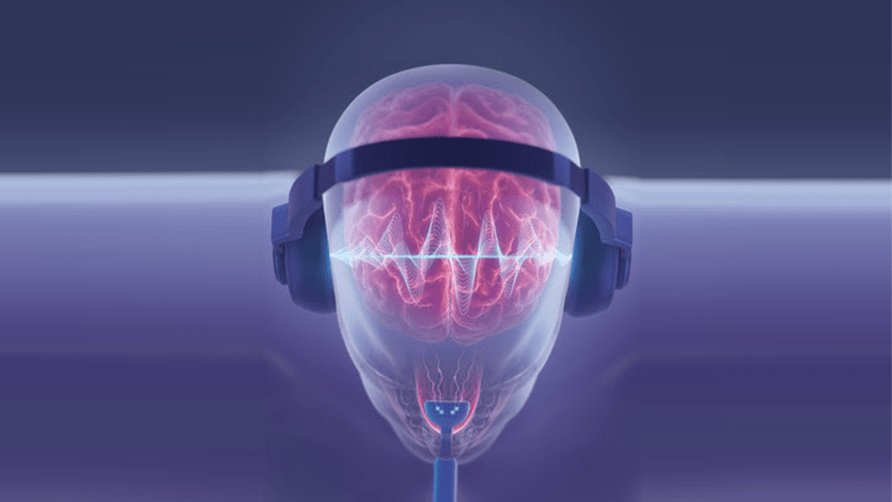
“Lenire Bimodal Neuromodulation Device …” from xtalks.com and used with no modifications.
At the core of Lenire’s effectiveness is its pioneering bimodal neuromodulation technology. This approach is grounded in the current scientific understanding that tinnitus stems from maladaptive neural activity across multiple brain regions. Rather than targeting just one sensory system, Lenire simultaneously stimulates both auditory and somatosensory pathways to promote beneficial neuroplasticity – essentially helping the brain to rewire itself to reduce tinnitus perception.
Sound Stimulation Component
The auditory component of Lenire delivers carefully calibrated sound sequences through comfortable wireless headphones. These aren’t simply random sounds or basic white noise – they’re precisely designed tonal patterns that change over time based on research into optimal auditory stimulation for tinnitus. The sounds are typically adjusted to each patient’s hearing profile and tinnitus characteristics during the initial fitting process.
What makes Lenire’s sound therapy different from traditional sound maskers is its dynamic nature. The sounds aren’t meant to simply cover up or distract from tinnitus; instead, they’re strategically designed to stimulate specific neural pathways in ways that complement the simultaneous tongue stimulation. This coordinated approach enhances the overall neuromodulatory effect, driving more significant changes in brain activity related to tinnitus perception.
Tongue Stimulation Mechanism
The truly innovative aspect of Lenire is its tongue stimulation component, delivered through a device called the Tonguetip®. This small, flat intraoral device sits comfortably on the anterior portion of the tongue and delivers mild electrical pulses that stimulate the dense network of sensory receptors found there. The tongue was specifically chosen as the stimulation site due to its rich sensory innervation and direct neurological connections to brain regions involved in tinnitus relief.
The electrical stimulation is carefully calibrated to be noticeable but comfortable – most patients describe it as a tingling or bubbling sensation on the tongue. The intensity can be adjusted based on individual comfort levels, and the stimulation patterns are precisely synchronized with the sound therapy component. This simultaneous activation of different sensory pathways is key to Lenire’s mechanism of action.
How These Work Together to Retrain the Brain
When the auditory and somatosensory stimulations occur simultaneously, they create a powerful combined effect on brain plasticity. This paired stimulation helps redirect and reorganize neural activity in regions associated with tinnitus, particularly the dorsal cochlear nucleus – an area where auditory and somatosensory pathways converge and which plays a significant role in tinnitus generation. Over time, this coordinated stimulation can help reduce hyperactivity in tinnitus-related neural networks.
The mechanism resembles principles seen in other neurological rehabilitation techniques, where paired stimuli are used to strengthen or redirect neural connections. With consistent daily treatment over the 12-week period, these neuroplastic changes can become more established, potentially leading to lasting reductions in tinnitus perception. Research indicates that this bimodal approach drives stronger neuroplasticity than either sound or tongue stimulation alone, which explains why Lenire outperforms traditional sound-only therapies in clinical studies.
Who Benefits Most from Lenire Treatment

“Lenire Tinnitus Treatment in Houston …” from fortbendhearing.com and used with no modifications.
While Lenire has shown broad efficacy across different tinnitus populations, certain patients tend to experience more pronounced benefits. The device is FDA-approved for adults 18 and older with moderate to severe tinnitus, as measured by standardized tinnitus assessment tools like the Tinnitus Handicap Inventory. Patients with more significant tinnitus-related distress often have the most to gain, with clinical data showing particularly strong outcomes for those who score at least 38 on the THI scale, indicating their tinnitus substantially impacts daily life.
Lenire can be effective regardless of the underlying cause of tinnitus, whether noise-induced, age-related, or associated with conditions like Meniere’s disease. The device has demonstrated benefits for patients with varying tinnitus characteristics, including different pitch perceptions and both unilateral and bilateral tinnitus. Importantly, Lenire can benefit patients who haven’t responded adequately to sound therapy alone, making it valuable for those who’ve tried and been disappointed by conventional treatments.
The ideal candidate is someone committed to the full 12-week treatment protocol, able to use the device consistently for 30-60 minutes daily. Patient motivation and adherence to the treatment schedule are key factors in achieving optimal results. Additionally, those who are comfortable using technology and can follow simple device instructions tend to have the most seamless treatment experience.
Ideal Candidates Based on Tinnitus Severity
Research indicates that Lenire is particularly effective for patients with moderate to severe tinnitus, defined as those scoring 38 or higher on the Tinnitus Handicap Inventory. This group often experiences substantial life disruption from their tinnitus, including sleep disturbances, concentration difficulties, and emotional distress. In clinical trials, patients with more severe baseline tinnitus typically showed larger absolute improvements in their THI scores after completing the Lenire treatment protocol.
However, Lenire can also benefit patients with milder tinnitus who still experience significant quality-of-life impacts. Even individuals with lower THI scores have reported meaningful improvements in tinnitus perception and associated distress after using the device. The key factor isn’t necessarily the objective loudness of the tinnitus but rather how bothersome it is to the individual and how much it interferes with daily activities and emotional well-being.
Timing can also influence treatment outcomes. While Lenire has shown effectiveness for both recent-onset and long-standing tinnitus, some evidence suggests that initiating treatment earlier may produce more robust results. This doesn’t mean those who’ve had tinnitus for many years won’t benefit – they absolutely can – but addressing tinnitus before neural patterns become deeply entrenched may provide some advantage.
Important Medical Contraindications
Despite its strong safety profile, Lenire isn’t appropriate for everyone. The device is contraindicated for patients with certain medical conditions or implanted devices. Specifically, individuals with pacemakers, defibrillators, or other active implanted devices should not use Lenire due to potential electromagnetic interference with the tongue stimulation component. Similarly, those with cochlear implants should avoid Lenire unless specifically cleared by their healthcare provider.
Other contraindications include pregnancy, active oral infections or open wounds in the mouth, a history of seizures or epilepsy, and certain neurological conditions. Patients with severe temporomandibular joint (TMJ) disorders may find the tongue device uncomfortable and might not be ideal candidates. Additionally, those with certain types of dental work, particularly extensive metal dental implants in the front of the mouth, might need evaluation before proceeding with treatment.
It’s worth noting that Lenire is approved only for adults 18 and older; safety and efficacy in children have not yet been established. All potential contraindications should be thoroughly discussed with a qualified healthcare provider during the initial consultation before beginning Lenire treatment.
The Patient Experience: What to Expect
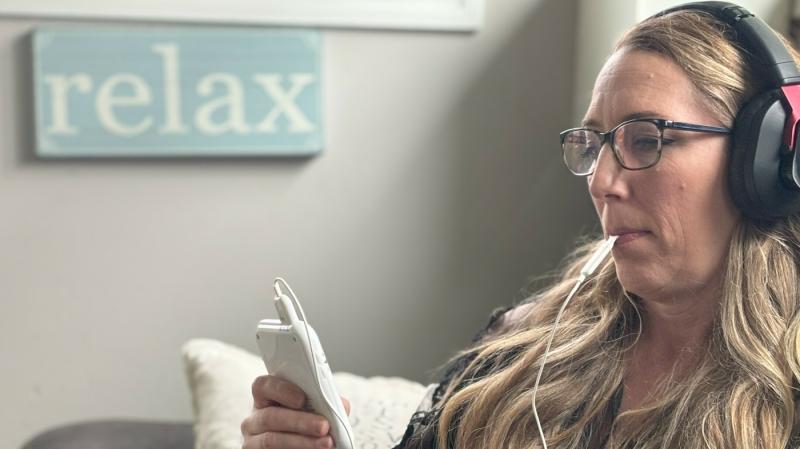
“Tinnitus Patient Stories | Experience …” from www.lenire.com and used with no modifications.
The Lenire treatment journey typically begins with a comprehensive evaluation by a qualified audiologist or tinnitus specialist. This initial assessment establishes baseline tinnitus severity, rules out any contraindications, and determines if you’re an appropriate candidate for the treatment. Patients should expect to complete standardized questionnaires like the Tinnitus Handicap Inventory (THI) or Tinnitus Functional Index (TFI), undergo hearing tests, and discuss their tinnitus history in detail.
Once deemed appropriate for treatment, you’ll be fitted with your personalized Lenire device. The fitting process involves customizing both the auditory stimulation based on your hearing profile and the tongue stimulation to comfortable intensity levels. You’ll receive thorough training on proper device use, maintenance, and the recommended treatment schedule. Most providers will also set up periodic check-ins throughout the 12-week treatment period to monitor progress and make any necessary adjustments.
Initial Assessment and Fitting Process
Your first appointment typically lasts 60-90 minutes and involves a comprehensive tinnitus evaluation. The provider will assess your tinnitus characteristics (pitch, loudness, location), conduct hearing tests, and review your medical history to ensure you’re a suitable candidate. You’ll complete standardized questionnaires to establish baseline tinnitus severity and impact on quality of life. This thorough evaluation helps your provider customize the Lenire protocol to your specific needs.
The fitting appointment focuses on configuring your Lenire device and teaching you how to use it properly. The sound component will be calibrated based on your hearing profile and tinnitus characteristics, while the tongue stimulation intensity will be adjusted to a level that’s noticeable but comfortable. You’ll practice inserting and removing the Tonguetip® device, operating the controller, and troubleshooting common issues. Most providers also create a personalized treatment schedule and review expectations for the 12-week protocol.
Typical Treatment Schedule
The standard Lenire protocol involves using the device for 30-60 minutes daily over a 12-week period. Most providers recommend consistent daily use at approximately the same time each day to establish a routine. The treatment sessions can be incorporated into quiet activities like reading, working at a desk, or relaxing, though you should avoid eating, drinking, or speaking while the Tonguetip® is in place.
Many clinicians structure the treatment with periodic follow-up appointments at 2, 6, and 12 weeks to monitor progress, address any challenges, and potentially fine-tune device settings. These check-ins are important for optimizing results and ensuring proper device use. Some providers also offer remote support between appointments via phone or telehealth to promptly address any questions or concerns. For a comprehensive understanding of remote support options, you can explore Oto for tinnitus, which offers insights into effective app-based management.
After completing the initial 12-week protocol, your provider will assess your results using the same standardized measures from your baseline evaluation. Based on your outcomes, they may recommend continued use at a reduced frequency (such as 2-3 times weekly) for maintenance, or in some cases, a second 12-week treatment cycle for those who showed partial improvement and desire additional benefit.
Common Side Effects and Their Management
Lenire has demonstrated an excellent safety profile in clinical trials and real-world use, with most side effects being mild and temporary. The most commonly reported side effect is a temporary change in tongue sensation, which typically resolves quickly after removing the Tonguetip® device. Some patients also report increased salivation during treatment sessions, which is a normal response to having the device in the mouth.
Less frequently, patients may experience minor discomfort in the jaw or tongue, mild headache, or temporary changes in taste perception. These effects are generally mild and tend to diminish as patients become accustomed to the device. If discomfort persists, your provider can adjust the stimulation intensity or recommend shorter initial sessions while you adapt to the treatment.
Serious adverse events are extremely rare with Lenire treatment. The clinical trials that led to FDA approval reported no device-related serious adverse events, supporting Lenire’s strong safety profile. As with any medical device, it’s important to report any unexpected or concerning symptoms to your healthcare provider promptly. For those exploring alternative treatments, you might find the Beltone Tinnitus Calmer to be a helpful option.
Timeline for Noticing Improvements
Patient response timelines vary considerably with Lenire treatment. Some individuals report noticeable improvements within the first 2-3 weeks of consistent use, while others experience more gradual changes that become apparent later in the treatment period. Clinical data suggests that the most substantial improvements typically occur between weeks 6 and 12 of the protocol, highlighting the importance of completing the full treatment course even if immediate results aren’t apparent.
It’s worth noting that tinnitus improvement isn’t always linear – some patients experience fluctuations in their symptoms throughout the treatment period before achieving more stable improvement. This pattern is normal and doesn’t indicate treatment failure. Your provider will assess your progress using standardized measures at specific intervals, providing objective tracking of your response over time.
Studies show that improvements gained during the initial 12-week treatment period can persist for 12 months or longer after completing the protocol. Some patients benefit from maintenance sessions to sustain their results, while others experience lasting improvement without continued use. Your provider will help determine the optimal long-term approach based on your individual response pattern.
Cost Considerations and Insurance Coverage

“Lenire® Tinnitus Treatment and Therapy …” from pacifichearinginc.com and used with no modifications.
Average Price Range
The total cost of Lenire treatment typically ranges from $3,000 to $5,000, depending on the provider and geographic location. This comprehensive price usually includes the device itself, all necessary components, the initial evaluation and fitting, and follow-up appointments throughout the 12-week treatment period. Some providers offer financing options to make treatment more accessible, with monthly payment plans typically ranging from $100-250 per month depending on the terms. When comparing costs between providers, it’s important to clarify exactly what’s included in the quoted price to ensure you’re making accurate comparisons. For those interested in alternative treatments, consider exploring the Beltone Tinnitus Calmer as another option.
Current Insurance Reimbursement Status
Insurance coverage for Lenire treatment is currently limited but evolving. As a relatively new FDA-approved device, many insurance plans don’t yet have established coverage policies for Lenire specifically. Some patients have successfully obtained partial reimbursement through their health insurance, particularly those with plans that cover durable medical equipment or have specific tinnitus treatment benefits. Medicare currently does not cover Lenire treatment, though this may change as more clinical data accumulates. Many providers offer insurance verification services to help determine potential coverage before beginning treatment, and some can provide documentation to support insurance claims or appeals if coverage is initially denied.
Finding a Qualified Provider for Lenire Treatment
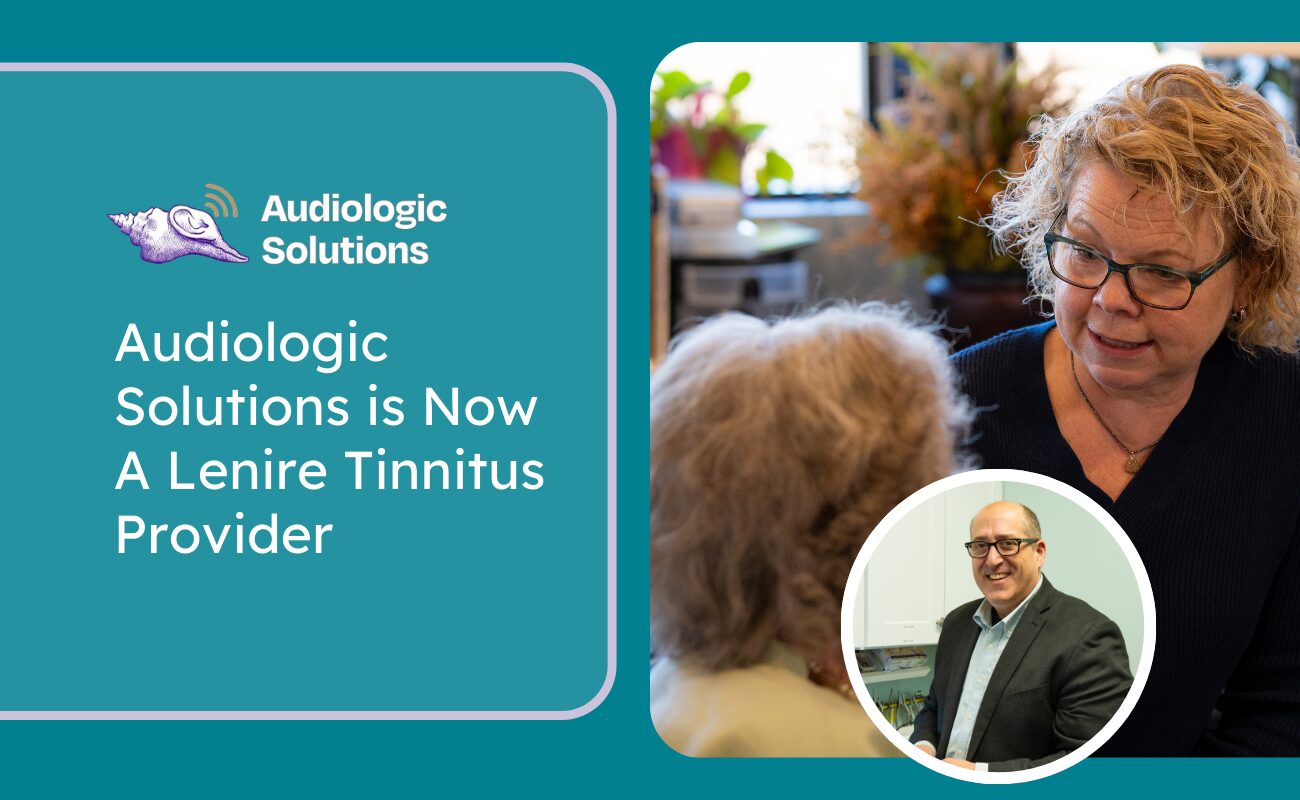
“Lenire Tinnitus Provider” from www.audiologicsolutions.net and used with no modifications.
Selecting the right provider is crucial for maximizing your Lenire treatment outcomes. The device should only be prescribed and fitted by healthcare professionals who have completed specific training in Lenire protocols. These providers are typically audiologists or otolaryngologists (ENT physicians) with specialized experience in tinnitus management. When searching for a provider, look for those who have completed official Lenire certification and regularly treat tinnitus patients.
The number of qualified Lenire providers is growing steadily across the United States since FDA approval, though availability varies by region. Neuromod Devices, the manufacturer of Lenire, maintains an official provider directory on their website that can help locate certified clinicians in your area. Many providers offer initial consultations to discuss whether you’re a good candidate for the treatment before committing to the full protocol. For alternative solutions, you might also explore the Beltone Tinnitus Calmer for tinnitus relief.
- Verify the provider’s specific training and experience with Lenire device fitting
- Ask about their success rates and how many Lenire patients they’ve treated
- Inquire about their complete treatment protocol, including follow-up care
- Discuss payment options and whether they offer any assistance with insurance claims
- Consider proximity and convenience, as you’ll need multiple appointments over 12 weeks
When possible, seek providers who offer comprehensive tinnitus care beyond just device fitting. The best outcomes often come from clinics that integrate Lenire into a holistic tinnitus management approach, including counseling on tinnitus coping strategies, sleep hygiene, and stress management techniques that complement the device’s neuromodulation effects. For additional support, consider exploring yoga for tinnitus relief as part of your management plan.
Frequently Asked Questions
As patients consider Lenire treatment, certain questions consistently arise during consultations. The following addresses the most common concerns based on both clinical experience and published research about the device’s effectiveness, compatibility with other treatments, and practical usage considerations.
How long do Lenire’s tinnitus relief effects last after treatment?
Clinical studies show that the benefits achieved during the 12-week Lenire treatment protocol can persist for 12 months or longer after completing treatment. The TENT-A1 follow-up study demonstrated that improvements in tinnitus severity were maintained for at least 12 months in the majority of participants who responded positively to the initial treatment. Some patients find that occasional maintenance sessions (1-2 times weekly) help sustain their improvements long-term, while others experience lasting benefit without continued use. The durability of results appears to correlate with treatment adherence during the initial protocol, highlighting the importance of consistent device use as directed.
Can I use Lenire if I wear hearing aids?
Yes, hearing aid users can typically use Lenire, though not simultaneously with their hearing aids. The treatment sessions are relatively short (30-60 minutes daily), so hearing aids can be removed during Lenire use and replaced afterward. For patients whose tinnitus is significantly exacerbated when their hearing aids are removed, providers may recommend scheduling Lenire sessions during times when the temporary absence of amplification would be least disruptive. To learn more about this new tinnitus treatment, check out Lenire’s efficacy and application.
Some audiologists even find that combining Lenire treatment with appropriate hearing aid use (at different times of day) provides complementary benefits, as improved hearing from amplification and neuroplastic changes from Lenire can work together to reduce tinnitus perception. Your provider can help develop an integrated treatment plan that optimizes both interventions if you’re a hearing aid user. For more information on effective therapies, consider exploring Widex Zen Therapy as a breakthrough in tinnitus relief.
Is the tongue stimulation uncomfortable or painful?
The tongue stimulation component of Lenire is designed to be noticeable but not painful. Most patients describe the sensation as a mild tingling, buzzing, or bubbling feeling on the tongue that’s easily tolerable. During the initial fitting, your provider will adjust the stimulation intensity to a level that’s comfortable for you personally. If you find the sensation too strong during home use, you can easily decrease the intensity using the device’s controller. The vast majority of clinical trial participants reported good tolerance of the tongue stimulation, with very few discontinuing treatment due to discomfort.
How does Lenire compare to sound therapy alone?
Clinical research directly comparing Lenire to sound therapy alone shows significantly better outcomes with the bimodal approach. The TENT-A3 trial specifically examined this question, finding that 70.5% of patients with moderate or worse tinnitus reported clinically significant improvement after adding tongue stimulation, even after experiencing insufficient benefit from six weeks of sound therapy alone. This evidence strongly suggests that the combination of auditory and somatosensory stimulation drives more powerful neuroplastic changes than sound alone can achieve. While sound therapy remains a valuable tinnitus management tool, Lenire’s bimodal approach appears to offer enhanced efficacy, particularly for patients with more severe or treatment-resistant tinnitus.
What percentage of patients report significant improvement with Lenire?
Clinical trials consistently show that approximately 80-85% of patients experience clinically significant improvement in tinnitus symptoms after completing the 12-week Lenire protocol. Specifically, the TENT-A3 trial reported that 79.4% of participants achieved clinically significant improvement, while real-world data from U.S. clinics has shown even higher response rates, with one study reporting 91.5% of patients experiencing meaningful reduction in tinnitus symptoms. “Clinically significant” improvement is typically defined as a reduction of 7 or more points on the Tinnitus Handicap Inventory or 13 points on the Tinnitus Functional Index – changes large enough to meaningfully impact quality of life. It’s important to note that while most patients improve, Lenire is not presented as a complete cure for tinnitus, but rather as an effective management approach that can substantially reduce symptom burden.
For tinnitus sufferers who have struggled to find relief through conventional treatments, Lenire offers a science-backed option with impressive clinical outcomes. The combination of strong efficacy data, minimal side effects, and non-invasive application makes it a valuable addition to the tinnitus treatment landscape. If you’re considering Lenire, consulting with a certified provider can help determine if you’re an appropriate candidate and set realistic expectations for your individual treatment journey.
